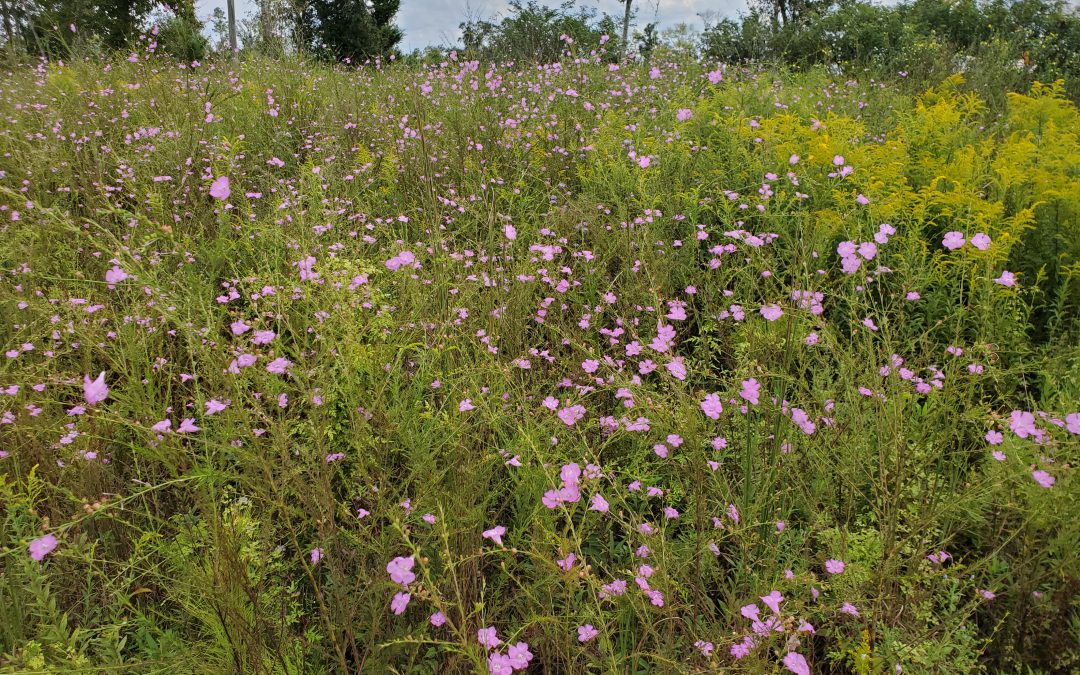
by Daniel J. Leonard | Sep 30, 2021
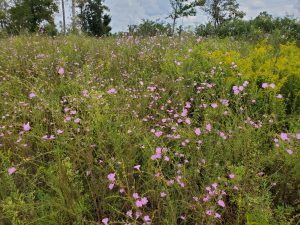
False Foxglove in a Calhoun County natural area. Photo courtesy of Daniel Leonard.
Fall is the absolute best season for wildflower watching in the Panhandle! When mid-September rolls around and the long days of summer finally shorten, giving way to drier air and cooler nights, northwest Florida experiences a wildflower color explosion. From the brilliant yellow of Swamp Sunflower and Goldenrod, to the soothing blue of Mistflower, and the white-on-gold of Spanish Needles, there is no shortage of sights to see from now until frost. But, in my opinion, the star of the fall show is the currently flowering False Foxglove (Agalinus spp.).
Named for the appearance of their brilliant pink flowers, which bear a resemblance to the northern favorite Foxglove (Digitalis spp.), “False Foxglove” is actually the common name of several closely related species of parasitic plants in the genus Agalinus that are difficult to distinguish by all but the keenest of botanists. Regardless of which species you may see, False Foxglove is an unusual and important Florida native plant. Emerging from seed each spring in the Panhandle, plants grow quickly through the summer to a mature height of 3-5’. During this time, False Foxglove is about as inconspicuous a plant as grows. Consisting of a wispy thin woody stem with very small, narrow leaves, plants remain hidden in the flatwoods and sand hill landscapes that they inhabit. However, when those aforementioned shorter September days arrive, False Foxglove explodes into flower sporting sprays of dozens of light purple to pink tubular-shaped flowers that remain until frost ends the season.
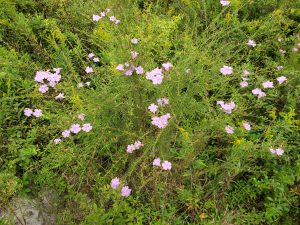
False Foxglove flowering in a Calhoun County natural area. Photo courtesy of Daniel Leonard.
In addition to being unmatched in flower, False Foxglove also plays several important ecological roles in Florida’s natural areas. First, False Foxglove’s relatively large, tubular-shaped flowers are the preferred nectar sources for the larger-sized native solitary and bumble bees present in the Panhandle, though all manner of generalist bees and butterflies will also visit for a quick sip. Second, False Foxglove is the primary host plant for the unique Common Buckeye butterfly. One of the most easily recognizable butterflies due to the large “eye” spots on their wings, Common Buckeye larvae (caterpillars), feed on False Foxglove foliage during the summer before emerging as adults and adding to the fall spectacle. Finally, False Foxglove is an important indicator of a healthy native ecosystem. As a parasitic plant, False Foxglove obtains nutrients and energy by photosynthesis AND by using specialized roots to tap into the roots of nearby suitable hosts (native grasses and other plants). As both False Foxglove and its parasitic host plants prefer to grow in the sunny, fire-exposed pine flatwoods and sand ridges that characterized pre-settlement Florida, you can be fairly confident that if you see a natural area with an abundance of False Foxglove in flower, that spot is in good ecological shape!
The Florida Panhandle is nearly unmatched in its fall wildflower diversity and False Foxglove plays a critical part in the show. From its stunning flowers to its important ecological roles, one would be hard-pressed to find a more unique native wildflower! For more information about False Foxglove and other Florida native wildflowers, contact your local UF/IFAS County Extension office.
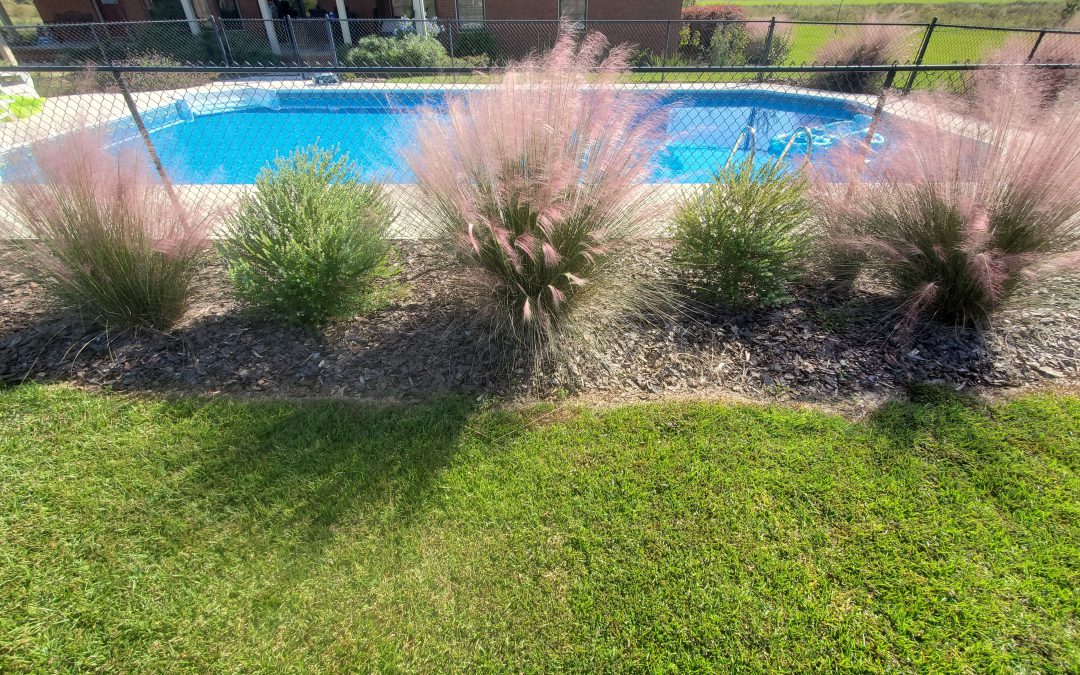
by Daniel J. Leonard | Oct 28, 2020
In the Panhandle, fall is the prettiest season for wildflowers. Our roadsides and woodlands are covered with pinks, whites, yellows, blues, purples, and even a little red here and there. Pretty as it may be, the beautiful wildflower look isn’t super appropriate for most yards. It would look unkempt, a little “wild” if you will, would be hard to manage and is probably best enjoyed in natural areas. However, we can bring some of the native colors of fall into our landscapes in a much lower maintenance, refined manner with two Panhandle species that pair excellently together, Muhly Grass (Muhlenbergia capillaris) and Darrow’s Blueberry (Vaccineum darrowii).
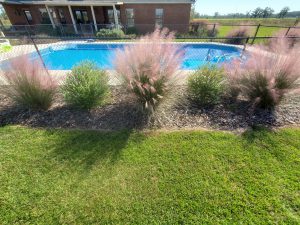
Muhly Grass and Darrow’s Blueberry in a local landscape. Photo courtesy of Daniel Leonard.
Muhly Grass, the native grass with the pinkish/purple panicles blooming right now, has gained much popularity in recent years, earning a reputation as a near pest/disease free, drought tolerant, attractive landscape plant. Operating in lieu of more traditional low growing shrubs in landscapes, Muhly is an airy, greenish gray bunch grass growing about 3-4’ tall and wide, lending informal, coastal texture to landscapes most of the year and really shining in fall during its flowering season. Once established, it never needs extra water, prefers little fertilizer, and only needs a rejuvenation prune (or burn – the Leonard preferred method. It’s fun and mimics the role of fire in Muhly’s native ecosystems!) every couple of years to keep it looking tidy.
Unlike Muhly Grass, Darrow’s Blueberry has not caught on broadly in the landscape industry but is no less deserving. This native blueberry species only grows a couple of feet tall, produces edible fruit that wildlife enjoy, and adds an unusual blue green color to landscapes via its tiny-leaved, evergreen foliage. It prefers the same sites as Muhly and is part of the reason they pair so well together. Our mostly sandy, well drained soils work just fine, but both plants can handle soils that are occasionally wet. A bonus, Darrow’s also has tiny, bell shaped flowers in spring that attract all manner of beneficial bee species. This makes it a must in any native pollinator garden!
As good as these species are alone, I think they are better together. In my family’s yard, we created a loose screen of widely spaced (8’ apart) Muhly Grass specimens around a pool, in the spirit of giving the area a “coastal” airy feel, and interspersed Darrow’s Blueberry in between.
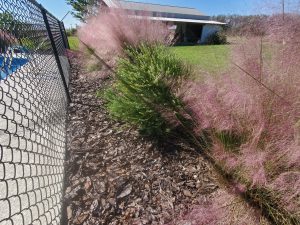
The pink Muhly Grass flowers pair nicely with the green blue foliage of Darrow’s Blueberry. Photo courtesy of Daniel Leonard.
The look has been outstanding, particularly in the late summer/early fall. The pinky purple flowers of Muhly Grass complement the green-blue foliage of the blueberries nicely and provide easy, lasting color without having to worry about planting finicky annuals or perennials each season.
Landscaping with natives does not have to look wild and unkempt, nor does it have to be drab and unattractive. Combining native yet showy plants like Darrow’s Blueberry and Muhly Grass makes for an unusual, refined, nearly no-maintenance feature in your landscape. Look for these and other neat native plants at native nurseries and independent garden centers around the Panhandle. If you’d like more information on native grasses, blueberries or any other horticultural topic, please contact your local UF/IFAS County Extension Office! Happy Gardening!

by Sheila Dunning | Oct 7, 2020
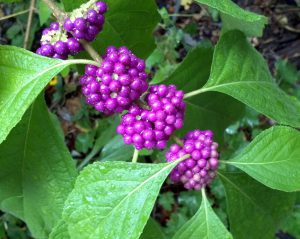
American Beautyberry Photo by: UF/IFAS
Each fall, nature puts on a brilliant show of color throughout the United States. As the temperatures drop, autumn encourages the “leaf peepers” to hit the road in search of the red-, yellow- and orange-colored leaves of the northern deciduous trees. In Northwest Florida the color of autumn isn’t just from trees. The reds, purples, yellow and white blooms and berries that appear on many native plants add spectacular color to the landscape. American Beautyberry, Callicarpa americana, is loaded with royal-colored fruit that will persist all winter long. Whispy pinkish-cream colored seedheads look like mist atop Purple Lovegrass, Eragrostis spectabilis and Muhlygrass, Muhlenbergia capillaris. The Monarchs and other butterfly species flock to the creamy white “fluff” that covers Saltbrush, Baccharis halimifolia. But, yellow is by far the dominant fall flower color. With all the Goldenrod, Solidago spp., Narrowleaf Sunflower, Helianthus angustifolius and Tickseed, Coreopsis spp., the roadsides are golden. When driving the roads it’s nearly impossible to not see the bright yellows in the ditches and along the wood’s edge. Golden Asters (Chrysopsis spp.), Tickseeds (Coreopsis spp.), Silkgrasses (Pityopsis spp.), Sunflowers (Helianthus spp.) and Goldenrods (Solidago spp.) are displaying their petals of gold at every turn. These wildflowers are all members of the Aster family, one of the largest plant families in the world. For most, envisioning an Aster means a flower that looks like a daisy. While many are daisy-like in structure, others lack the petals and appear more like cascading sprays.

Helianthus
So if you are one of the many “hitting the road in search of fall color”, head to open areas. For wildflowers, that means rural locations with limited homes and businesses. Forested areas and non-grazed pastures typically have showy displays, especially when a spring burn was performed earlier in the year. Peeking out from the woods edge are the small red trumpet-shaped blooms of Red Basil, Calamintha coccinea and tall purple spikes of Gayfeather, Liatris spp. Visit the Florida Wildflower Foundation website, www.flawildflowers.org/bloom.php, to see both what’s in bloom and the locations of the state’s prime viewing areas. These are all native wildflowers that can be obtained through seed companies. Many are also available as potted plants at the local nurseries. Read the name carefully though. There are cultivated varieties that may appear or perform differently than those that naturally occur in Northwest Florida. For more information on Common Native Wildflowers of North Florida go to http://edis.ifas.ufl.edu/ep061.
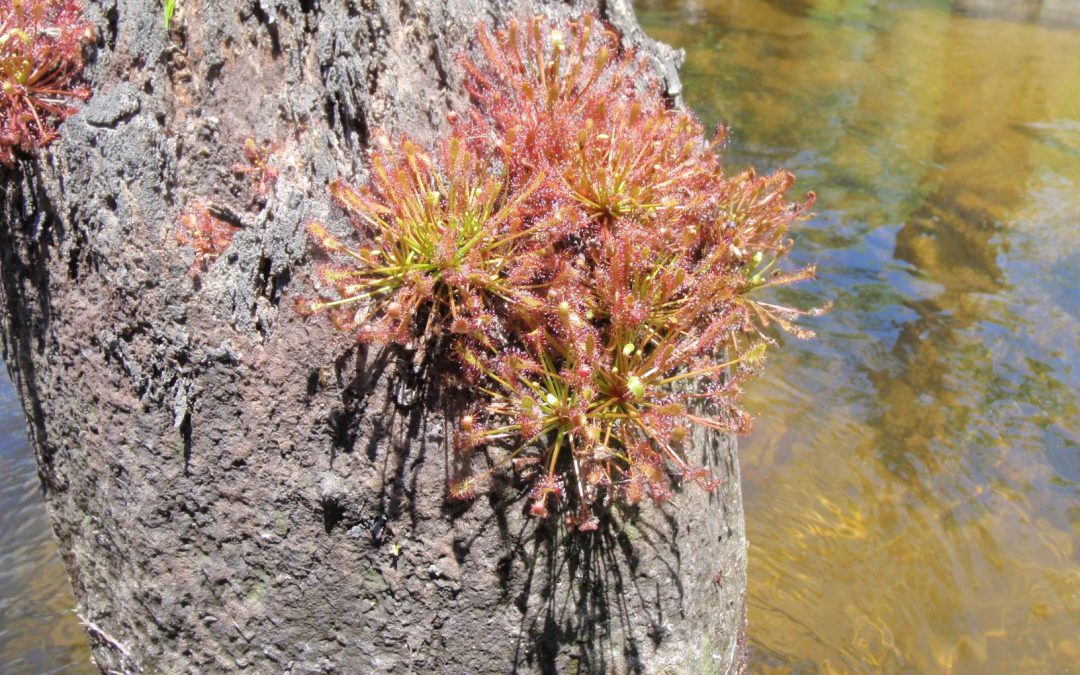
by Carrie Stevenson | Jun 4, 2020
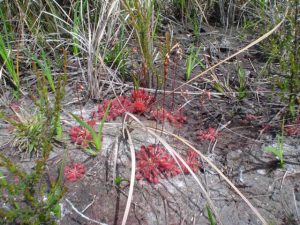
Sundews, tiny carnivorous plants found in pitcher plant bogs, use an enzyme dissolve insect proteins. Native Americans recognized this property and used the plant for skin maladies. Photo credit: Carrie Stevenson, UF IFAS Extension
There are few words better than “pure delight” to describe the face of someone who sees and appreciates a sundew for the first time. Maybe it is their size—often no bigger around than a quarter—or the miniature pinwheel shape, but sundews could easily fit into a fable about garden gnomes or fairies in the woods. These tiny plants hide in plant sight–so small and flush to the ground that you likely won’t see them unless specifically looking for them. But, once you are looking in the right conditions, you will probably see them everywhere.
Sundews (Drosera spp.) are small carnivorous plants found in the same bogs as pitcher plants. They thrive in moist, mucky soil and full sun. They are also carnivorous for the same reasons pitcher plants are—their wet, acidic habitats possess few soil nutrients, so they use insects instead.
Sundews utilize a different method for trapping insects—their flat, radiating structure has wider lobes on the ends, which are covered with hairlike tentacles. These hairs secrete droplets of sticky sap visible at the tip of each hair. Small insects are attracted to the dewlike sap and get stuck. The hairs curl around the insect like a slow Venus flytrap, and natural enzymes to break down the bug.
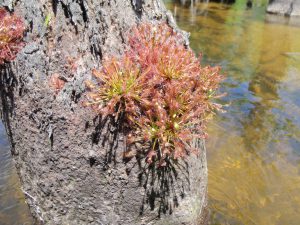
A healthy sundew plant growing just above the water level at Boiling Creek in Santa Rosa County. Photo credit: Larry Burner, Florida Master Naturalist
There are almost 200 species of sundews, not all with the flat growth pattern. The threadleaf sundew has an upright structure, while others may grow in a spherical shape at the water’s edge. While paddling Boiling Creek on Eglin Air Force Base property a few years ago, our group saw dozens of sundews growing on the trunks of cypress and tupelo trees at eye-level from our kayaks. They were about 4-6” in diameter, much larger than the 1” ones we typically see in the bogs.
Tarkiln State Park, Weeks Bay National Estuarine Research Reserve, or any place you find pitcher plants are a great place to find sundews. You may have to get on your knees to see them, and move the grasses aside. Bring a hand lens to magnify the delicate details of the droplets of sap perched at the tip of tiny hairs.
Even the famous naturalist Charles Darwin was enthralled with sundews, conducting experiments and writing volumes about them. In an 1860 letter to his geologist friend Charles Lyell, Darwin stated that, “at the present moment, I care more about Drosera than the origin of all the species in the world.” If you, too, are fascinated with carnivorous plants, check out these resources from UF IFAS Extension and the Botanical Society of America.
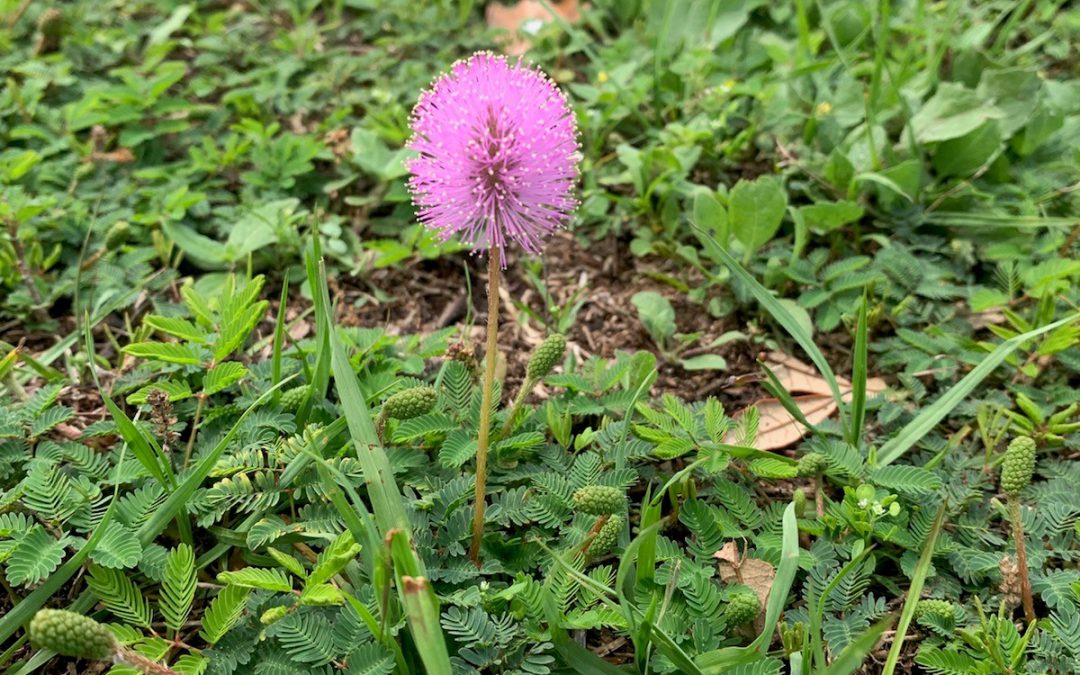
by Ray Bodrey | May 13, 2020
Powderpuff mimosa (Mimosa strigillosa), also called Sunshine Mimosa or Sensitive Plant, is an increasingly popular native plant for home and commercial landscape applications that offers a very show display of puffy pink flowers this time of year!
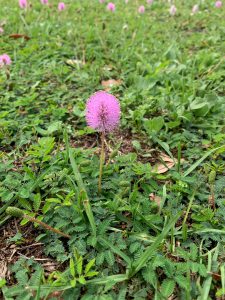
Powderpuff Mimosa, (Mimosa strigillosa). Photo courtesy of Ray Bodrey.
This Florida native, low-growing groundcover grows no more than eight inches in height, and that would be classified as an extremely vigorous stand. Powderpuff Mimosa is technically a perennial legume, meaning it doesn’t need any nitrogen fertilizer from gardeners.
The groundcover is appealing to the eye with its dark green fern-like leaves. Not an evergreen, the plants fall into a semi-dormant to dormant state during the fall and winter seasons. Powderpuff Mimosa is a very resilient groundcover as well, needing little irrigation, spreading quickly, and co-existing well with turfgrass. Just a few pots of this species transplanted should cover up to 300 square feet in a season. Although it spreads quickly, it can easily be pruned or mowed if it moves into unwanted areas.
Powderpuff mimosa is a great plant for erosion control due to its deep roots. These deep roots also allow for good levels of drought tolerance. There are very few insect or disease problems with this plant, other than the occasional caterpillar. It is a very wildlife and pollinator friendly plant, with honeybees, butterflies, deer, and more all finding it appealing. It’s even considered a livestock forage, as cattle find it palatable.
Looking to plant powderpuff mimosa in your landscape? Any area that gets mostly full sun is just fine. This plant is adapted to a wide range of soils, but particularly flourishes in well-drained, sandy loam soils. Be sure to water regularly, especially to ensure successful establishment in your landscape. Find this wonderful little plant at Florida native plant nurseries!
For more information contact the Gulf County Extension Office at 639-3200 or email at rbodrey@ufl.edu.
Supporting information for this article can be found in the UF/IFAS Extension website: https://gardeningsolutions.ifas.ufl.edu/plants/ornamentals/powderpuff-mimosa.html & USDA website: https://plants.usda.gov/plantguide/pdf/pg_mist2.pdf
UF/IFAS Extension is an Equal Opportunity Institution.













